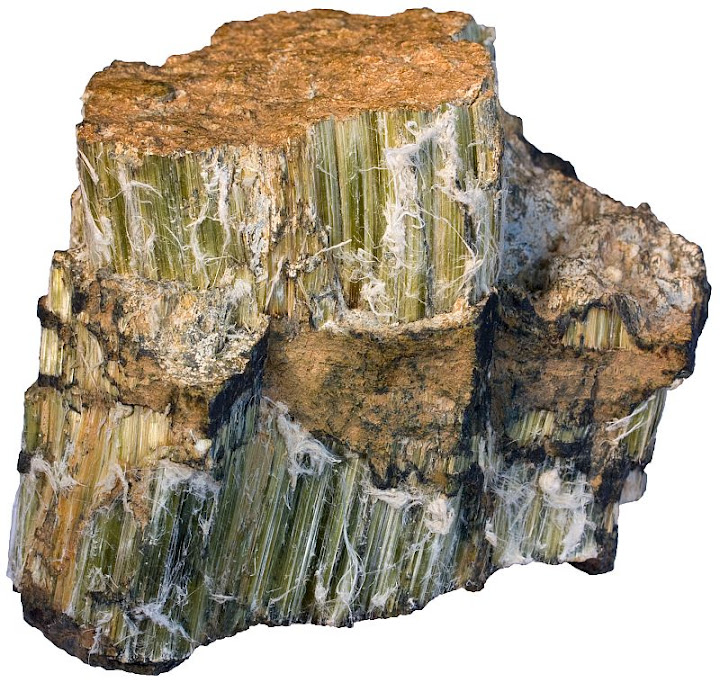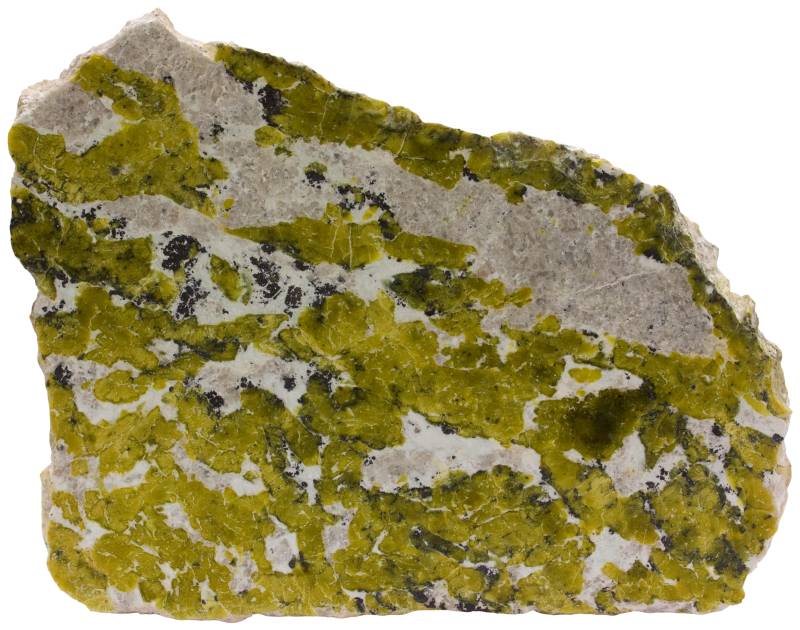Serpentinite is a metamorphic rock that is mostly composed of serpentine group minerals. Serpentine group minerals antigorite, lizardite, and chrysotile are produced by the hydrous alteration of ultramafic rocks. These are igneous rocks that are composed of olivine and pyroxene (peridotite, pyroxenite). Serpentine group minerals occur less commonly in some olivine-bearing marbles (ophicalcite) and kimberlites, but these rocks are normally not considered to be serpentinites.

Serpentinite from the Troodos ophiolite in Cyprus.
Serpentinites form as a result of serpentinization. These are chemical reactions which convert anhydrous ferromagnesian silicate minerals (pyroxene, olivine) into hydrous silicate minerals (serpentine) plus some other possibilities like brucite and magnetite. Brucite forms if the precursor rocks are rich in magnesium (dunite, for example). Magnetite forms if there is enough iron present (pyroxenite). Usually serpentinite contains iron in the form of magnetite which gives dark color to serpentinites.
Serpentinite is probably very widespread rock deep below, but not nearly as common in the upper parts of the crust. Here it occurs mostly where ultramafic rocks occur (ophiolite complexes). Serpentine minerals along with other green-colored alteration minerals (talc and chlorite) are still pretty widely distributed because olivine and pyroxenes are readily available in many places. Serpentinites has been important sources of asbestos, but nowadays the use of asbestos has diminished considerably because of health concerns.
These concerns may actually be greatly exaggerated because there is not much good evidence that chrysotile (serpentine asbestos which makes up more than 90% of all asbestos mined) poses any significant risks to our lungs. The danger associated with asbestos comes mostly form amphibole asbestos minerals, but it is hopeless to assume that the fearmongering media would take the trouble and educate themselves and their readers about the different types of asbestos minerals. So, we continue to see dangers in harmless amounts of chrysotile asbestos in floor tiles while we neglect or happily tolerate far more important health risks like fast food and lack of physical exercise (which kills millions every year).

Serpentinite where the dominant serpentine mineral is fibrous chrysotile. The sample is from the Sayan Mountains in Siberia. Width of sample is 8 cm.

Serpentinite (green) with white magnesite from Norway. Serpentine and magnesite may occur together if there were enough carbon dioxide available during the metamorphism to form magnesium carbonate magnesite. Width of sample 24 cm.

Serpentine-rich skarn sample with hedenbergite (iron-rich Ca-clinopyroxene). Serpentine in skarn may form if the carbonate host rock is dolomite that provides lots of magnesium to form magnesium-rich silicates like serpentine minerals. Tapuli, Sweden. Width of sample 13 cm.
two questions — is it possible to tell what kind of asbestos is in a building, for example during remodeling? And how does serpentinite relate to serpentine? … on the California coast, serpentine is habitat to an interesting suite of endemic plants. And now a third … might you do a post on fuchsite one of these days? (found in our local green quartzite, http://plantsandrocks.blogspot.com/2012/03/there-is-one-bed-of-bright-emerald.html)
I am not sure about the first one. I think it would be good start to investigate who’s products are the building materials used in the building and then ask them directly what kind of asbestos they used then. Another way is to take a small sample of the material and send it to some mineralogy lab for X-ray testing.
Serpentinite is a rock. Serpentine is a mineral or more precisely mineral group. Serpentinite is composed of serpentine. Here it becomes evident that such names have their disadvantages. It is good to remember that serpentinite is composed of serpentine but most people won’t make a difference and in the end it will be a mess.
I will write about fuchsite some day, there is no doubt about it. I have several nice photos of fuchsite and have several still unphotographed samples in my own rock collection as well. I am not yet sure whether I will write a separate post about fuchsite or write about it as part of a muscovite post. I read your post about fuchsite quartzites.
Thanks for the info — ha ha! so California has it backwards, they claim their State Rock is serpentine 🙂 In any case, I will be looking for serpentinite and its interesting ecology in a few months, hopefully finding enough material for a post.
I look forward to your fuchsite/muscovite post. I’m planning another field trip to the green quartzite quarry this summer, after the high-country is snow-free.
Yes, poor Californians didn’t get it right here 🙂
Yes, we Californians (well, most of us anyway) don’t know the difference between serpentine and serpentinite. Some of our elected representatives don’t know that there are non-asbestiform minerals in the serpentine group, and that they form the bulk of the serpentinite exposed in the state. There was a dust-up last year when some dimbulb legislator decided we should change the state rock, because *gasp*! Serpentine is Asbestos, which is Evil! I don’t think that proposal went anywhere.
Serpentinite is probably my favorite rock, and I’m fortunate not to live too far from an area where you can collect it in roadcuts. I also make beaded jewelry, and my favorite bead supplier sells serpentinite beads both under the names “serpentine” and “new jade” — but they explain “new jade” is a trade name for “serpentine”. I can forgive them for “serpentine”, even though the beads have magnetite inclusions, but “new jade”? Gaaah!
Yep, these so-called trade names are disturbing and may cause lots of trouble. Jade, for example, is an especially nasty term because it may mean several different things (amphiboles, pyroxenes). And now even serpentine too. But we can’t change that. We can only try to educate people which I attempt to do with this blog. Its only a drop of water in the sea but hopefully better than nothing.
can serpentineites be formed from serpentine rich melt directly or just with the hydration of precursor rock ?
I’m just starting to look at different of rocks at an art angle and it’s interesting hearing all this information thanks
Kenny
Serpentine was declared the California state rock in 1965. At that point, I’m not sure US geologists had yet started using “serpentinite” as the name for the rock. According to the Simon and Schuster book on “Rocks and Minerals” (originally written by some Italians), Europeans use both “serpentine” and “serpentinite” as names for *different forms* of serpentine-based rocks.